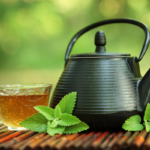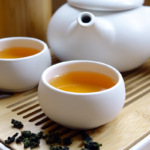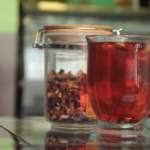Introduction
The cultivation and production of special and rare teas have garnered significant attention and popularity in recent years. These teas, known for their unique flavors and health benefits, are highly sought after by tea enthusiasts around the world. This blog aims to explore the art of producing and cultivating these special teas, delving into their origins, cultivation processes, and the regions specialized in their production.
II. Types of Special and Rare Teas
A. White Tea
White tea is one of the most delicate and sought-after varieties of tea. It is characterized by its subtle flavors and minimal processing. Originating from China, white tea is made from the young leaves and buds of the tea plant, carefully plucked during the early spring harvest. The leaves are then withered and dried, preserving their natural essence and delicate taste. White tea is known for its low caffeine content and abundant antioxidants.
B. Green Tea
Green tea, another popular type of special tea, is widely consumed for its numerous health benefits. It originated in China and is produced by gently heating or steaming the freshly picked leaves to halt oxidation. The leaves are then rolled and dried, preserving their vibrant green color and unique flavors. Green tea is known for its high levels of antioxidants, which are believed to promote heart health and boost metabolism.
C. Oolong Tea
Oolong tea is a partially oxidized tea that falls between green and black tea in terms of processing and flavor. It is known for its complex flavors and aroma. Originating from China and Taiwan, oolong tea is produced through a meticulous process that involves withering, rolling, and partially fermenting the leaves. The oxidation level can vary, resulting in a diverse range of oolong teas, each with its unique characteristics and taste profiles.
D. Black Tea
Black tea, the most oxidized type of tea, is renowned for its robust flavors and bold aroma. It is commonly consumed in Western countries, particularly in the form of breakfast teas. Black tea undergoes a complete oxidation process, in which the leaves are withered, rolled, fermented, and then dried. This oxidation process gives black tea its distinctive color, flavor, and caffeine content.
III. Regions Specialized in the Production of Special and Rare Teas
A. China
China is a country with a rich tea culture and is renowned for producing some of the finest and rarest teas in the world. Some of the main regions specialized in the production of special and rare teas include Fujian, Yunnan, and Anhui. These regions have unique soil and climate conditions that contribute to the exceptional quality and flavor profiles of their teas. For example, Fujian produces renowned white teas such as Bai Hao Yin Zhen (Silver Needle) and Bai Mu Dan (White Peony).
B. India
India is another significant player in the production of special and rare teas, with its famous Darjeeling and Assam teas being highly regarded worldwide. Darjeeling tea, grown in the Darjeeling district at the foothills of the Himalayas, is known for its muscatel flavor and delicate aroma. Assam tea, on the other hand, is grown in the northeastern state of Assam and is known for its strong, malty flavor, making it an excellent choice for breakfast teas.
C. Japan
Japan is renowned for its green teas, particularly matcha, gyokuro, and sencha. Matcha, a powdered green tea, is traditionally used in Japanese tea ceremonies and is made by stone grinding shade-grown tea leaves. Gyokuro, considered the highest grade of green tea, is grown in the shade for several weeks before harvest, resulting in a sweeter and more complex flavor. Sencha, the most common type of green tea in Japan, is made from the top leaves of the tea plant and has a refreshing, grassy taste.
IV. The Process of Cultivating Special and Rare Teas
The cultivation process of special and rare teas requires meticulous attention to detail and adherence to specific techniques.
A. Selection and Planting of Seedlings
The journey of producing special and rare teas begins with the selection of high-quality tea seedlings. These seedlings are carefully chosen based on their genetic attributes, including flavor, aroma, and resilience to pests and diseases. Once selected, the seedlings are planted in well-prepared fields or specialized nurseries, where they are nurtured until they are ready for transplantation to the cultivation areas.
B. Soil and Climate Care
The soil and climate play a crucial role in the cultivation of special and rare teas. These teas thrive in specific conditions that contribute to their unique flavors and profiles. The soil must be well-drained, rich in organic matter, and possess the right balance of minerals. The climate should have adequate rainfall, moderate temperatures, and sufficient sunlight. Farmers employ various techniques to maintain and improve the soil quality, such as mulching and composting, to provide the tea plants with optimal growing conditions.
C. Harvesting at the Ideal Time
Harvesting the tea leaves at the perfect time is essential to the quality and flavor of the final product. For different types of teas, the harvest time may vary, but it typically involves plucking the young, tender leaves and buds at their peak maturity. The plucking is usually done by hand to ensure the utmost care and precision. During the harvest season, multiple rounds of plucking may occur to accommodate the growth cycle of the tea plants.
D. Leaf Processing
After the leaves are harvested, they go through specific processing methods depending on the type of tea being produced. The different processing techniques, such as rolling, withering, fermentation, and drying, contribute to the unique characteristics and flavors of the teas. For example, white tea undergoes minimal processing, with the leaves simply withered and dried. In contrast, black tea undergoes complete oxidation, resulting in its bold flavor profile. The processing techniques are carefully followed to preserve the nuances and qualities of each tea.
E. Storage and Aging
Once the tea leaves are processed, they are stored in optimal conditions to ensure their quality and preserve their flavors. Some teas, especially oolong and pu-erh teas, benefit from aging, as it allows the flavors to mature and develop further. Proper storage techniques, such as storing in airtight containers and maintaining consistent humidity levels, are essential to prevent deterioration of the tea leaves over time.
V. Preparation and Consumption of Special and Rare Teas
To fully enjoy the unique flavors and aromas of special and rare teas, proper preparation and consumption techniques are essential.
A. Preparation Methods
There are various methods of preparing special and rare teas, including infusion, gong fu cha, and ceremonial brewing. Infusion is the most common method, where hot water is poured over the tea leaves and allowed to steep for a specific duration. Gong fu cha, a traditional Chinese method, involves multiple short steepings using a small teapot and small teacups. Ceremonial brewing, as seen in the Japanese tea ceremony, emphasizes the mindful and ceremonial aspects of tea preparation. Each method allows for a unique experience and brings out different aspects of the tea’s flavors.
B. Tips for Appreciating Flavors
To fully appreciate the flavors and aromas of special and rare teas, it is important to pay attention to the brewing parameters, such as water temperature and steeping time. The ideal brewing parameters vary depending on the type of tea being prepared. For example, delicate white teas require lower water temperatures and shorter steeping times, while robust black teas can withstand higher temperatures and longer steeping times. Experimenting with different brewing parameters and taking note of the subtle changes in flavor can enhance the overall tea-drinking experience.
C. Gastronomic Combinations and Pairings
Special and rare teas can be enjoyed not only on their own but also paired with various foods to create harmonious flavor combinations. For example, delicate white teas pair well with light desserts, such as fruit tarts or macarons. Green teas complement savory dishes like sushi or steamed dumplings. Oolong teas, with their complex flavors, can be enjoyed with roasted meats or rich desserts. Exploring different gastronomic combinations can elevate the tasting experience and create delightful pairings.
VI. Health Benefits and Curiosities of Special and Rare Teas
Special and rare teas have long been associated with various health benefits and boast a rich history and cultural significance.
A. Nutritional and Medicinal Properties
These teas are known for their abundance of antioxidants, which help combat oxidative stress and promote overall well-being. They also contain various polyphenols, amino acids, and vitamins that contribute to their health benefits. For example, green tea is believed to aid in weight loss and boost metabolism, while oolong tea is associated with improving digestion and mental alertness. The unique nutritional profiles of special and rare teas make them an excellent choice for those seeking natural and holistic ways to support their health.
B. Scientific Studies and Recent Discoveries
Scientific studies have extensively researched the health benefits of special and rare teas, shedding light on their potential therapeutic properties. Research has shown that these teas can be beneficial in preventing chronic diseases, reducing inflammation, and improving cardiovascular health. Additionally, recent studies have explored the potential anti-cancer properties of some teas, highlighting their promising role in cancer prevention and treatment. These scientific findings provide further support for the consumption of special and rare teas for their health-enhancing properties.
C. Cultural and Historical Significance
Special and rare teas have a rich cultural and historical significance in the regions where they are produced. For example, the Chinese tea ceremony, an ancient tradition, embodies the harmony between nature, tea, and human consciousness. In Japan, the tea ceremony represents a deeply spiritual practice focused on mindfulness and respect. Understanding the cultural and historical context surrounding these teas adds depth and appreciation for their unique qualities beyond their flavors and health benefits.
VII. Conclusion
In conclusion, the cultivation and production of special and rare teas are a true art form, creating beverages that captivate the senses and offer a myriad of health benefits. From delicate white teas to robust black teas, each type has its unique flavors, cultivation processes, and regions specialized in its production. Embracing the art of preparing and consuming these teas allows us to appreciate their nuances fully. Through ancient traditions and scientific discoveries, the richness and value of special and rare teas continue to be celebrated. So, take a sip, embark on a journey of flavors, and explore the wonders of these precious gifts from nature.






